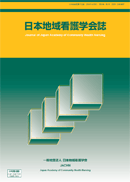Volume 18, Issue 2-3Comb-No
Displaying 1-8 of 8 articles from this issue
- |<
- <
- 1
- >
- >|
-
Article type: Article
2015Volume 18Issue 2-3Comb-No Pages 4-12
Published: December 20, 2015
Released on J-STAGE: April 20, 2017
Download PDF (1031K) -
Article type: Article
2015Volume 18Issue 2-3Comb-No Pages 13-22
Published: December 20, 2015
Released on J-STAGE: April 20, 2017
Download PDF (1116K) -
Article type: Article
2015Volume 18Issue 2-3Comb-No Pages 23-32
Published: December 20, 2015
Released on J-STAGE: April 20, 2017
Download PDF (1166K) -
Article type: Article
2015Volume 18Issue 2-3Comb-No Pages 33-40
Published: December 20, 2015
Released on J-STAGE: April 20, 2017
Download PDF (1050K) -
Article type: Article
2015Volume 18Issue 2-3Comb-No Pages 41-50
Published: December 20, 2015
Released on J-STAGE: April 20, 2017
Download PDF (1609K) -
Article type: Article
2015Volume 18Issue 2-3Comb-No Pages 51-60
Published: December 20, 2015
Released on J-STAGE: April 20, 2017
Download PDF (1240K) -
Article type: Article
2015Volume 18Issue 2-3Comb-No Pages 61-68
Published: December 20, 2015
Released on J-STAGE: April 20, 2017
Download PDF (902K) -
Article type: Article
2015Volume 18Issue 2-3Comb-No Pages 69-78
Published: December 20, 2015
Released on J-STAGE: April 20, 2017
Download PDF (1358K)
- |<
- <
- 1
- >
- >|
